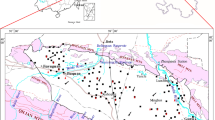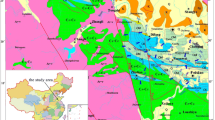Abstract
Based on the study of groundwater isotope(2H and 18O, 34S, 15N, 3H, 14C) in Changzhou, Wuxi and Suzhou area, it is found that the deep confined groundwater has no pollution on the whole, whereas the shallow groundwater is polluted to a different degree in the area. The deep confined aquifers (main exploitation aquifers) in Changzhou area and in Wuxi and Suzhou area likely belong to two different aquifers. The main exploitation aquifers in Changzhou area are not connected with those in Wuxi and Suzhou area, or they are connected but not expedited. The lateral run-off of groundwater is at present directed to the exploitation center because of overexploitation of the deep groundwater for a long time, but the flowing speed of groundwater is still extremely slow. The deep confined groundwater is in a close to half close state. The 14C age of groundwater varies from 10000 a BP to 38000 a BP, with the oldest groundwater found at the nearest exploitation center (along the line of three cities of Changzhou, Wuxi and Suzhou) and the youngest at the furthest exploitation center.
Similar content being viewed by others
References
Sheng X F, Yu J J. Conference summary of the international environmental isotopic hydrology and China countermeasures. Hydrogeol Eng (in Chinese), 2004, (1): 114–115
Man K Y. Investigation on movement of groundwater by environmental isotope 18O, D, T. J Northern Jiaotong Univ (in Chinese), 1994, 18(1):50–55
Xiao F, Wang Z M, Li S. The application of isotopic technique to the hydrogeological condition research in a nuclear waste disposal site. Uranium Geol (in Chinese), 1995, 11(4): 244–253
Chen Z Y, Zhang G H, Nie Z L, et al. Groundwater Isotopic Stratification and Its Implicationsin Northern China. Earth Sci — J China Univ Geosci (in Chinese), 2002, 27(1): 97–104
Li W P, Hao A B, Zheng Y J, et al. Regional environmental isotopic features of groundwater and their hydrogeological explanation in the Tarim Basin. Earth Sci Front (in Chinese), 2006, 13(1): 191–198
Wang R J. Isotope hydrogeology in Xishan, Taiyuan. Acta Geol Sin (in Chinese), 1985, (4): 97–104
Liu C F, Wang P Y, Zhou L. The environment significance of H, O, C and Cl isotopic composition in groundwater of Hebei plain. Earth Sci Front (in Chinese), 1997, 4(1–2): 267–274
Wei Y M, Li J F, Sun J P. Application of environmental isotope to the prospecting of groundwater resources in a city. Expl Sci Tech (in Chinese), 2001, (1): 38–44
Zhuang J. Application of environmental isotopic methods to the prospecting of mining groundwater resources. Coal Geol China (in Chinese), 1997, 9(2): 47–48
Gao Z F. Evaluation of groundwater resource with the applied environmental isotopic method in Northwest, China. Acta Geol Gansu (in Chinese), 1995, 4(1): 62–72
Wu J F, Zhu X Y. Environmental isotope study and water resource evaluation in Kouquangounan water resource site. Coal Geol Expl (in Chinese), 1997, 25(3): 35–39
Weng D G. Groundwater resources attribute based on environmental isotopes. Earth Sci — J China Univ Geosci (in Chinese), 2002, 27(2): 141–147
Zhu L N, Wang R J, Ke C L. Application of environmental isotope in studying the influence of fly ash leaching on groundwater. Res Environ Sci (in Chinese), 2002, 15(4): 31–53
Zhang C Y, Zhong Z S, Shen Z L. The Progress in the study of oxygen isotopes in groundwater nitrate. Earth Sci Front (in Chinese), 2003, 10(2): 287–290
Zhou A G, Chen Y Z, Cai H S, et al. New way in No3 −-N contamination study of water environment: Correlative method of 15N & 18O. Earth Sci — J China Univ Geosci (in Chinese), 2003, 28(2): 219–224
Heaton T H E. Isotopic studies of nitrogen pollution in the hydrosphere and atmosphere: A review. Chem Geol, 1986, 59: 87–102
North J C, Frew R D, Peake B M. The use of carbon and nitrogen isotope ratios to identify landfill leachate contamination: Green Island Landfill, Dunedin, New Zealand. Environ Inter, 2004, 30(5): 631–637
Wang Y H, Shen H T. Research methods of sedimentary rate in channel-mouth coast environment. Mar Geol Quat Geol (in Chinese), 2002, 22(2): 115–120
Ha C Y, Wang R J. The information about sea level changes inferred from groundwater. Earth Sci Front (in Chinese), 1996, 3(1–2): 177–181
Jiang Y H, Dai Q J, Wang Y P, et al. The negative environmental effects of groundwater exploitation in the Yangtze river delta and their preventive countermeasures. Volcanol Mineral Res (in Chinese), 2000, 21(3): 214–225
Hu J P, Wu S L. Groundwater environmental problems in Suzhou-Wuxi-Changzhou urbanized region. Hydrogeol Eng Geol (in Chinese), 1998, 25(4): 5–7
Xue Y Q, Zhang Y, Ye S J, et al. Land subsidence in China and its problems. Quat Sci (in Chinese), 2003, 23(6): 585–593
Guo K Y, Yu J, Fang Z, et al. Groundwater exploitation and geological hazard. Nature (in Chinese), 2005, (3): 17–18
Yu J, Wang X M, Su X S, et al. The mechanism analysis on ground fissure disaster formation in Suzhou-Wuxi-Changzhou area. J Jiling Univ (Earth Sci ed.) (in Chinese), 2004, 34(2): 236–241
Lu X R, Zhu J Q, Wang C H, et al. Explanation of the shallow groundwater cycle mechanism with isotope technology in Suzhou, Wuxi and Changzhou area. Hydrogeol Eng Geol (in Chinese), 2006, 33(4): 52–55
Wassenaar L. Evaluation of the origin and fate of nitrate in the Abbotsford aquifer using the isotopes of 15N and 18O in NO3 −. Appl Geochem, 1995, 10: 391–405
Rademach J J, Young T B, Kanarek M S. Gastric cancer mortallity and nitrate levels in Wisconsinn drinking water. Archives Environ Health, 1992, 47: 292–294
Aravena R, Evans M L, Cherry J. Stable isotopes of oxygen and nitrogen in source indentification of nitrate from septic systems. Ground Water, 1993, 31: 180–186
Kendal L C, Silvas R, Chang C C Y, et al. Use of the δ 18O and δ 15N of nitrate to determine sources of nitrate in nearly spring runoff in forested catchments. Isotopes Water Res Manag, 1996, 1: 167–176
Bohlke J K, Erikseng E, Reves Z K. Stable isotope evidence for an atmospheric origin of desert nitrated posits in northern Chile and southern California, USA. Chem Geol, 1997, 136: 135–154
Author information
Authors and Affiliations
Corresponding author
Additional information
Supported by the China Geological Survey (Grant Nos. 200312300013, 1212010340106, 121201063400 and 1212010634404)
Rights and permissions
About this article
Cite this article
Jiang, Y., Jia, J., Xu, N. et al. Isotopic characteristics of groundwater in Changzhou, Wuxi and Suzhou area and their implications. Sci. China Ser. D-Earth Sci. 51, 778–787 (2008). https://doi.org/10.1007/s11430-008-0055-y
Received:
Accepted:
Published:
Issue Date:
DOI: https://doi.org/10.1007/s11430-008-0055-y




